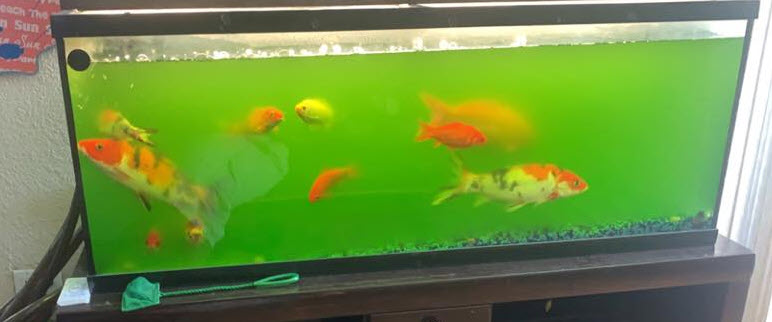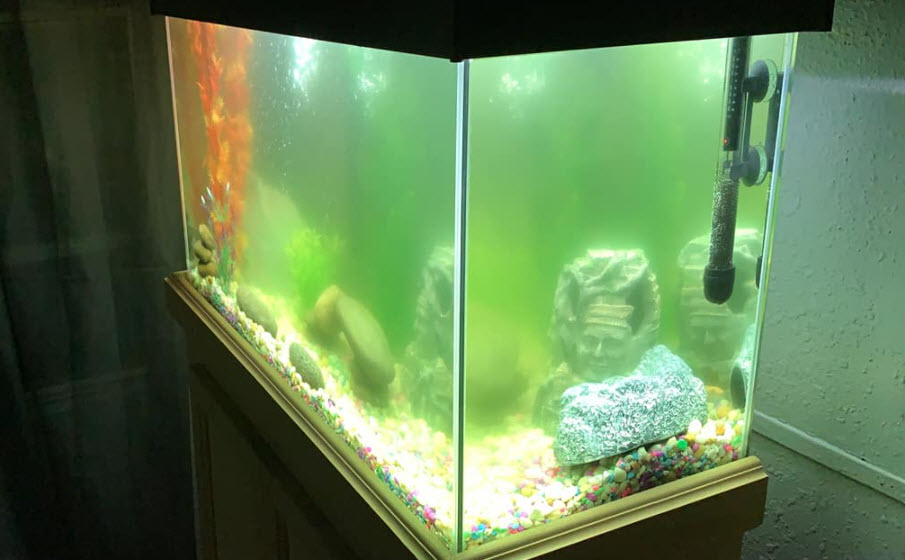Green Water is algae suspended in the water column of the aquarium. Typically a microscopic analysis will reveal many different types of algae in green water. There are almost always also a lot of “infusoria” in the water, minute microscopic critters and bacteria. So this literally is a soup of many different organisms.
Most green water algae blooms occur in new tanks less than three months old. With new tanks the best course of action is to NOT do any water changes and just wait it out. Add no chemicals. Do no cleaning of ANYTHING. Check the pH and bring it up to 7.0 minimum with baking soda or crushed coral. Then simply have patience and in two to six weeks the filter will remove all the green in the water, often overnight. Remember, there are three key attributes of a successful aquarist: PATIENCE, PATIENCE AND PATIENCE.
With tanks established over three months check the nitrate levels. If the nitrate is off the scale (like over 80 ppm) it is best to simply do one 95% water change. Contrary to popular mythology, large water changes are perfectly natural (a fish swimming in a river has a water change every second) and harmless to fish. It does NOT “shock” them. Most fish deaths during water changes are due to two things: on municipal water it is most often a chlorine pulse and on well water it is most often lack of oxygen in the water. After the water change do NOTHING for at least six weeks. Only keep the pH above 7.0 with baking soda or crushed coral.
If the nitrate level is not high then just treat it like a new tank. Do NOTHING for at least six weeks. Just let the Mother Nature do what Mother Nature does, namely establish a mature aquarium with a good “ecology” in it. Only keep the pH above 7.0 with baking soda or crushed coral.

Green Water During Cycling
An aquarium which is cycling can literally become “pea soup”. This is very common when cycling a new aquarium, especially if one leaves the lights on for any period of time. If one gets green water when cycling without fish simply turn the lights off and do no water changes. Lights are not needed during fishless cycling.
If one gets green water during cycling with fish in the aquarium there are two different courses of action open:
- black out the tank and use some large airstones and a decent sized air pump to aerate the aquarium very well. Do no water changes.
- leave the lights on 24 hours a day and do no water changes.

Now everyone on social media will tell you to simply black out the new aquarium even if it has fish in it. This is a mistake if you aren’t well aerating the aquarium. If the lights are turned out in an aquarium with both fish and a lot of green algae in it, a toxic cascade can occur.
- The algae die without light.
- The dead algae are attacked by bacteria.
- The bacteria bloom uses up most of the oxygen in the water.
- The dead algae release large amounts of ammonia
- And the fish suffocate.
Note one shouldn’t cycle with lights. Any algae which grow can absorb the ammonia that the beneficial bacteria need for growth.
If one is cycling an aquarium and you start doing water changes to eliminate something like green water you end up removing the nutrients the beneficial bacteria need. So I do not recommend water changes with green water while cycling.

Cycling requires patience. It is very common to get green or cloudy water when cycling. Just waiting it out for two to four weeks will generally result in the water turning crystal clear literally overnight (the change is quite dramatic and startling!). Doing something like water changes and/or tank cleaning can prolong the agony for many weeks.
What many don’t realize is that all living organisms need significant amounts of both nitrogen and phosphate inside their cells to replicate and to metabolize. So growing colonies of beneficial bacteria absorb ammonia, nitrite, nitrate and phosphate. And thus beneficial bacterial growth can stop algae blooms.
The newbie should just leave the tank alone, just continuing to add whatever feed they have decided on (food or ammonia). Leaving the aquarium alone allows the algae bloom nutrients to transfer from the water column to the filter media. The water will typically clear quite dramatically in a few weeks and all is well.

Hier is een link naar alle verschillende aspecten van de honderden manieren om een tank in te draaien (merk op dat de meeste van deze methoden "visloos" indraaien zijn):
Note that most of the time green tanks have fish in them. This means that the cycling needs to be done carefully. There is a balance to be struck between feeding the beneficial bacteria ammonia and keeping the ammonia levels below 3 to 4 pm to prevent damage to the fish. This “fish-in” cycling is covered in depth in this link:
Causes of Green Water in an Established Aquarium
There are many possible reasons for “green water” in an established aquarium over three months old.
Typically there will be more than one of these issues with the aquarium:
- The light is on too long or too intense. Sunlight for even a few hours a day can produce huge algae blooms.
- Phosphate has built up in the aquarium above 0.1 ppm from some source. If a tank has been cycled and established for several months and it gets green water which won’t go away, look for a phosphate source, either a plant fertilizer or a low pH buffer. If these have been used, do some 80% to 100% water changes to remove the phosphates.
- Nitrates have built up in the aquarium to above 80 ppm. If one is lax in water changes the nitrate can get above 80. While this typically won’t harm adult fish it will give fuel to an algae bloom. So one needs to check the nitrate levels and do water changes accordingly.
- There are no plants in the aquarium. Plants give out chemicals that inhibit algae growth. Plants also absorb phosphates, nitrates and iron, which can prevent algae growth. But note that moderate fish stocking does not lend itself well to good plant growth. The aeration needed for the fish removes the carbon dioxide needed for the plant growth.

UV-sterilisatie
UV will definitely clear up green water. But the underlying problem will remain. Since the various factors which contribute to green water are not addressed by using UV, it is a Band aide at best. So we do not recommend using UV to solve green water. But we do decidedly recommend UV units for over all aquarium health. Here is a link explaining UV sterilization

Chemical Algae Control
We do not recommend chemicals to treat algae. Any chemicals (save antibiotics for “blue green algae”) which kill algae will also kill both plants and fish. Specifically, API Algaefix and Tetra Algae control (same chemical – Polyquaternium WSCP) have killed tanks of fish.
Here is an interesting write-up on Tetra Algae Control:

And a write up on API Algaefix:

So Tetra Algae Control and API Algaefix have killed tanks even when used at the proper dosage. This is a very good reason not to use these products.
Some recommend using gluteraldehyde (Flourish Excel™) to control algae. Gluteraldehyde is very closely related to formaldehyde and is a disinfectant with no place in the aquarium. This chemical may kill algae, but it will also kill a lot of plants and burn and severely irritate fish’s gills if the dose is even slightly over the recommended dosage. Specifically, there have been several planted aquarium enthusiasts on social media reporting they’ve killed all the plants in their aquarium with Gluteraldehyde. Another social media quote is apropos:
“HELP! A total of 7 of my fish died after I dosed Flourish Excel”
Excel is gluteraldehyde. Gluteraldehyde kills fish.

Hydrogen peroxide is NOT harmless to fish. The “nascent” oxygen produced by hydrogen peroxide will burn the gills of the fish and can kill them.
The only exception to the rule that chemicals can kill fish are antibiotics. Antibiotics are harmless to fish. But unfortunately antibiotics only kill “blue-green algae” since this “algae” is actually a bacteria. And antibiotics can subtly harm fish by killing the beneficial bacteria in the filter. This can produce ammonia and nitrite spikes and damage the fish.
But, in any case, the copper, API Algaefix, Tetra Algae Control, Flourish Excel™, hydrogen peroxide and the antibiotics are only temporary reprieves. They only kill the algae temporarily. If the underlying problem isn’t solved the algae comes back in a week or two. So I have no use for chemical control of algae.
Sometimes a class of chemicals called “coagulants” is used to do chemical control of algae. They work by bonding the particles of algae together, which helps settle them out of the water and allows the filter to more easily mechanically filter them out. But these chemicals also coagulate the proteins and red blood cells in the gills of the fish. So they are also poisonous to fish.



